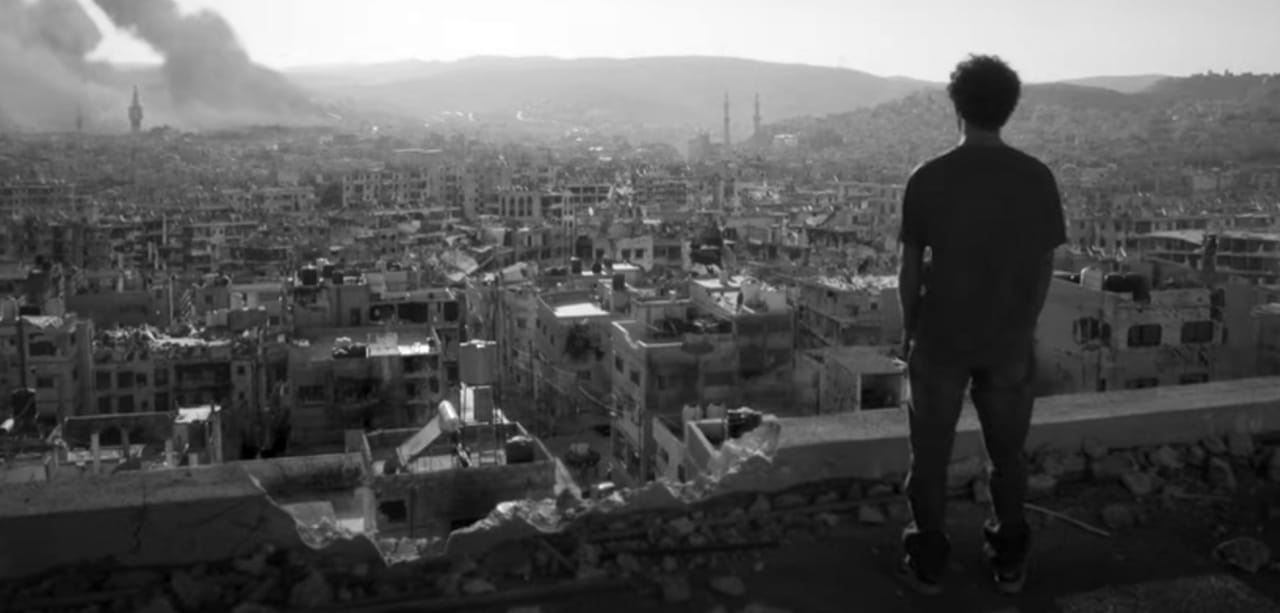In the last few years, we have been involved in researching the topic of repatriation and reintegration of returnees from Syria and Iraq to France and Belgium. The topic is not the easiest one to research and to communicate about, especially with the public, so as researchers we are always interested in artistic forms that can enable the mediation and translation of our work, such as film, documentary, and theater. As researchers, we also look quite critically at works that aim at producing entertainment and sensationalism and fail to convey the complexity of the topic. Watching Rebel, an action film on the topic of our research, was therefore quite a risky pleasure.
[Spoiler alert: the piece reveals details about the plot]
The storyline
Up and coming young Belgian directors Adil El Arbi and Bilall Fallah have become quite well-known in the last years for action cinema (i.e. Bad Boys for Life, Ms. Marvel, and -the cancelled- Batgirl). In an interview for the public broadcaster of the Flemish Community in Belgium they called Rebel, their most recent film, ‘their most personal film to date’. As Belgian Muslims of Moroccan descent they have witnessed many young people from their own neighbourhood and surroundings leave for Syria and Iraq, boys and girls they knew well. At the same time, they said that they have often been ‘asked about what they thought of the attacks in Europe or of the horrible images that reached us from Syria’. Rebel is their answer to that, a film they said, ‘they had to make’.
The story is told from the different perspectives of three main characters who live in Molenbeek, Brussels: Kamal Wasaki (Aboubakr Bensaihi), his brother Nassim (Amir El Arbi), and their mother, Leila (Lubna Azabal). All three eventually end up departing for Syria, albeit for different reasons.
First, we follow rapper Kamal through Brussels, who lives at the edges of the law and eventually gets into trouble with the police about his drug trade. Portrayed as intending to escape Belgian justice and concerned about the fate of Muslim brothers in the Middle East, he decides to depart to Syria to help the victims of the Syrian civil war and of Bashar al-Assad. After some time in Syria, he ends up in the grip of Islamic State against his will, and as a cameraman he is tasked with filming their “heroic” battlefields, violence and executions which they are extremely proud to show off and to carefully stage. This documentation task continues until Kamal himself is asked to commit to violence and participate in executions, this time not with a camera but with a gun.
When the video that shows Kamal executing a group of prisoners with other Islamic State soldiers surfaces, in his homeland, Belgium, Kamal is labelled as a murderous terrorist. During this time, his 12 years old brother, Nassim, undergoes profound confusion and alienation both from his mother and his community and refuses to believe that his brother has become a terrorist. This troubled state of mind and deep love for his brother make him an easy prey of a ‘recruiter’ who, by not labelling Kamal a murderer and a terrorist like others do, transfigures him into a hero of the jihad instead, something that soothes the heart of young Nassim, who, as a result, decides to follow the traces of his big brother and travels therefore to Syria.
Their mother, Leila, is portrayed as a tragically helpless but rather dignified character as she tries to do everything in her power not to lose her children, especially her younger son, Nassim. The film documents the passive (and even instigating) attitude of the Belgian police and of the social services, something that resonated with us, as in our research with families we have heard stories about their powerlessness and the abandonment from the state, the intimidating police checks, and the stigmatization within their work environments and community.
Changing perceptions or stereotypical counter-propaganda?
Rebel essentially attempts to change the general perception about the departure of Europeans to the war in Syria. All the European states that have experienced departures have introduced legislation incriminating people leaving for Syria. The film re-establishes some of the complexity of this immigration, which was initially linked to the sensitivity and religious attachment of young Europeans to the Syrians massacred by Bashar al-Assad’s regime. The first part of the film sets out the repression of the Syrian Spring and the feeling of guilt that seizes part of the Muslim youth in community spaces such as Molenbeek. In this part there is a rather admirable critical sociological attitude that places a part of the departures to Syria within the framework of an inter-Muslim and humanist solidarity, even if the facts are tainted by the narrative plot of a mother who kicks out her son following his troubles with the police.
The two Belgian-Moroccan directors enact a logic of solidarity with the Muslim community, which exposes them to criticism of ordinary racism in Europe. Through art and music they represent a resisting urban culture, characterised by community solidarity, strong bonds between parents and children of immigration, the hard work of parents for the education of their children despite the violence of systemic exclusion by the Belgian state. The profound link with the Arabic language, art and religion which is stigmatised in Europe, is restored by the two directors by figuring in the film people almost exclusively from postcolonial Moroccan immigration. From the shisha bar to the ruins of Raqqa, the choreography and the rapping (by acclaimed Belgian-Moroccan dance choreographer Sidi Larbi Cherkaoui), and the time-honoured poetic lyrics in Arabic, are courageous and compelling elements. The resistance of the urban peripheries to dominant cultures and structures is in fact one of the major gestures made by the film.
In the first part, the film also presents the directors’ commitment to the research of the reality of departures. Syria is presented at the beginning of the film in realistic terms: Bashar al-Assad’s regime is destroying its people, something which affects the solidarity of Muslims throughout the world. Affirming such a real postulate on the Syrian war through images can be already conceived as a major advance in the West. The directors also touch upon the transformations of radical groups and their exit from the revolution: it is the scene in the film where the Islamic State comes to kill a Syrian who opposes the fragmentation of the revolution. This is when the film’s hero, Kamal Wasaki, is practically kidnapped in Syria. Yet again, this brief scene only suggests an extended reality of a major revolution, namely the Arab Spring and the bonds of solidarity between Muslims in the East and the children of immigration. A solidarity betrayed by the rise of the fascist figure of the Islamic State.
Differently from the first part, in the second part, the film seems to give way to stereotypes that are far from the reality documented by research, and returns to the straight line of a counter-propaganda discourse that reduces the “enemy” to absolute barbarism and does neither question the Syrian resistance against the Islamic State, nor the internal crises and struggles of the jihad migrants within it. The Islamic State drawn by the film is reduced to a group of Syrian Arabs whose sole mission was to swindle young European victims controlled by evil ‘recruiters’ originating from the Muslim community itself.
The film represents a European viewpoint, including that of the Moroccan community of Muslims, that sees the departures to Syria as a fundamental mistake and a trap set for young people in search of an ideal. Of course, the choice of the directors to follow the trajectory of a single person, while understandable, does not allow the portrayal of the plurality of motivations for engagement that we find instead through research. The major problem is portrayed in the film as arising is in the host society, Syria, which is presented in a unified vision that contrasts with the testimonies of some returnees and shows (while essentialising) the violence of the people without inscribing it in the logic of the state. The testimonies that have been brought into attention through our research, confirm the opposite: the violence of the Islamic State existed within a state vision based on courts and administrative rationalisation based on bureaucratic terrorism. In the film, this violence is reduced to people -Muslim-Arabs- with no vision or characteristics other than essentialised violence. These, in order to execute harm, pursue naïve Europeans and Muslim communities by means of malevolent ‘recruiters’, described according to the classic scheme of criminal thugs who are after money. Religion is simply added to their criminal intentions.
Within these immigrant neighbourhoods, several figures in fact emerge: the criminal using religion for purely criminal and unjustified reasons (this is the case of the ‘recruiter’ Idriss); a second figure, embodied by Kamal, the “hero”, referring to humanist values but where religiosity has only an invisible place; a third figure relayed both by mother Leila and Imam Yusuf, an example of solidarity, of the religion of tolerance and of insertion into the lower economic and political scales of the society. Compared with this community of European Muslims, the Syrian Arabs are shown as barbarians representing extreme otherness. They are represented as vengeful and definable by the sole prism of absolute violence. Contrary to the reality of the internal struggle that has plagued the various groups of the Islamic State and allowed the revolution to be maintained, Syrian society is presented under the prism of a homogeneous group turned against the humanist ideal.
Beyond the scenes of the second part that racialise Arab populations based on a savagery whose origins and multiple responsibilities are fixed at the level of religion, the film fails to refer to the different belligerents within which the violence of the Islamic State is implemented (invasion of Iraq, redeployment of international armies, vassalisation of groups by the interests of colonial powers such as Russia). Besides the clear separation introduced between Europe and the Middle East, the film does not allow for a close analysis of the totalitarian organisation of the Islamic State. Undocumented and less plausible scenes, such as the formation of a section of the “caliphate’s cubs” within the state, picking up immigrant children in “minivans”, or the resale of women and the use of hard drugs, can be seen as a caricature that does not take seriously the totalitarian nature of the Islamic State, which is based on a rationalisation of violence and war.
In Rebel, Muslim communities in Europe gain a new representation regarding departures to Syria and political solidarity. This new representation does not include religion in the single category of violence, terrorism and “radicalisation”. We thus see the emergence of a young humanist, educated in solidarity, committed to and sensitive to the pain of others and revolted against the police in the West and the police who are establishing themselves in a totalitarian regime in the East. But the major loser remains the figure of the Muslim in the Orient, condemned to an essentialist image that does not allow us to understand the logic of the enslavement and brutalisation and overshadows the multiple resistances within the revolution in Syria.
The authors work together in the project Reguide.
Cover image: still from the movie.

